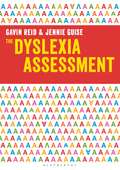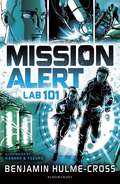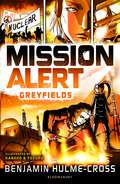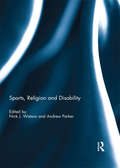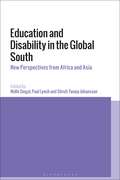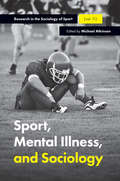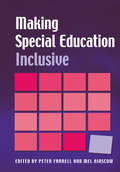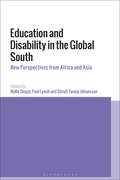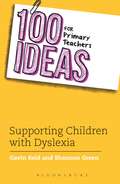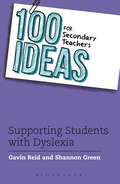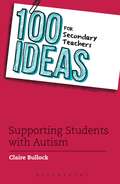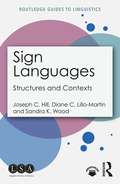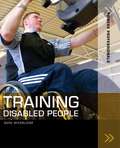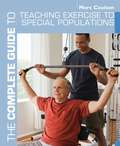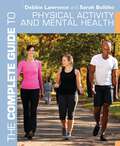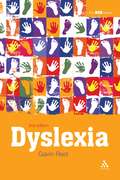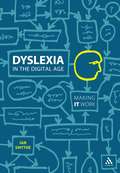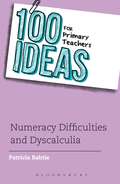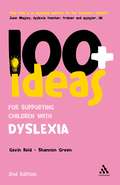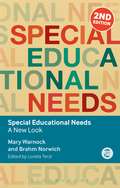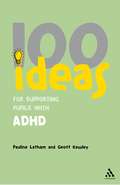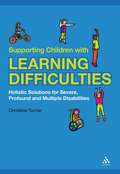- Table View
- List View
The Dyslexia Assessment
by Gavin Reid Jennie GuiseThe Dyslexia Assessment is a complete assessment tool for investigating reading, writing and spelling difficulties in learners. Written by leading experts Gavin Reid and Jennie Guise, this practical guide aims to clarify the ambiguities and uncertainties that exist around the dyslexia assessment and is applicable to all education sectors, including early years, primary, secondary, further and higher education. The book provides practical and comprehensive guidance on carrying out an assessment for dyslexia through informal and formal strategies, and interpreting and acting on results. It features assessment sheets, including questionnaires, forms and checklists that can be photocopied or downloaded from an accompanying website. The strategies explored focus on the whole learner, taking into consideration social, emotional and motivational factors, as well as the challenges of assessing learners with overlapping conditions or EAL.This practical and invaluable guide will inform and empower all mainstream and specialist teachers, teaching assistants, SENCOs and psychologists to provide the best support possible for learners with reading, writing or spelling difficulties.
Mission Alert: Mission Alert (High/Low)
by Mr Benjamin Hulme-CrossWhen the only way to get at a target is by using a child, MI5 bring in special agents Tom and Zilla to help. On a school trip to a robotics lab, Tom and Zilla need to figure out how to stop an army of robots being hired out to criminal gangs. Join them as they investigate the secrets of Lab 101.Bloomsbury High Low books encourage and support reading practice by providing gripping, age-appropriate stories for struggling and reluctant readers, those with dyslexia, or those with English as an additional language. Printed on tinted paper and with a dyslexia friendly font, Mission Alert is aimed at readers aged 8+ and has a manageable length (72 pages) and reading age (7+). This collection of stories can be read in any order.Produced in association with reading experts at CatchUp, a charity which aims to address underachievement caused by literacy and numeracy difficulties.Book band: Brown
Mission Alert: Mission Alert (High/Low)
by Mr Benjamin Hulme-CrossWhen the only way to get at a target is by using a child, MI5 bring in special agents Tom and Zilla to help. Something is going on at Greyfields nuclear power plant and Tom and Zilla need to find out what. Can they sneak into a camp of anti-nuclear protesters and foil the plans of a Russian spy? Bloomsbury High Low books encourage and support reading practice by providing gripping, age-appropriate stories for struggling and reluctant readers, those with dyslexia, or those with English as an additional language. Printed on tinted paper and with a dyslexia friendly font, Mission Alert is aimed at readers aged 8+ and has a manageable length (72 pages) and reading age (7+). This collection of stories can be read in any order.Produced in association with reading experts at CatchUp, a charity which aims to address underachievement caused by literacy and numeracy difficulties.Book band: Brown
Making Special Education Inclusive: From Research To Practice
by Peter Farrell Mel AinscowThe aim of this book is to consider how schools and LEAs can develop inclusive policies and practices for students who experience a range of difficulties in learning or behavior. It highlights debates and contradictions about the realities of inclusion and suggests ways in which practice can move forward. The contributors look at key areas of development in special and inclusive education and considers ways in which the latest research can inform practice. Areas covered include promoting inclusion for all; how to make sense of the Code of Practice SEN Thresholds; working with Teaching Assistants; new approaches to counseling and pastoral care in schools; including pupils with EBD; how nurture groups are helping inclusive practice; making education inclusive for pupils with sensory disabilities; including pupils with specific learning difficulties; and preparing students for an inclusive society. The book will be of particular interest to teachers, LEA support staff, educational psychologists and related professionals who face the challenge of meeting the needs of a diverse population within an inclusive framework. it will also be of relevance for students in further and higher education, and their tutors.
Making Special Education Inclusive: From Research To Practice (PDF)
by Peter Farrell Mel AinscowThe aim of this book is to consider how schools and LEAs can develop inclusive policies and practices for students who experience a range of difficulties in learning or behavior. It highlights debates and contradictions about the realities of inclusion and suggests ways in which practice can move forward. The contributors look at key areas of development in special and inclusive education and considers ways in which the latest research can inform practice. Areas covered include promoting inclusion for all; how to make sense of the Code of Practice SEN Thresholds; working with Teaching Assistants; new approaches to counseling and pastoral care in schools; including pupils with EBD; how nurture groups are helping inclusive practice; making education inclusive for pupils with sensory disabilities; including pupils with specific learning difficulties; and preparing students for an inclusive society. The book will be of particular interest to teachers, LEA support staff, educational psychologists and related professionals who face the challenge of meeting the needs of a diverse population within an inclusive framework. it will also be of relevance for students in further and higher education, and their tutors.
Education and Disability in the Global South: New Perspectives from Africa and Asia
by Nidhi Singal Paul Lynch Shruti Taneja JohanssonEducation and Disability in the Global South brings together new and established researchers from a variety of disciplines to explore the complexities and dilemmas encountered in providing education to children and young people with disabilities in countries in South Asia and Africa. Applying a range of methodological, theoretical and conceptual frameworks across different levels of education systems, from pre-school to higher education, the contributors examine not just the barriers but also the opportunities within the educational systems, in order to make strong policy recommendations. Together, the chapters offer a comprehensive overview of a range of issues, including a nuanced appreciation of the tensions between the local and global in relation to key developments in the field, critiquing a globalized notion of inclusive education, as well as proposing new methodological advancements in taking the research agenda forward. Empirical insights are captured not just from the perspectives of educators but also through engaging with children and young people with disabilities, who are uniquely powerful in providing insights for future developments.
Sport, Mental Illness and Sociology (Research in the Sociology of Sport #11)
by Michael AtkinsonAt a time when the public discussion of mental illness in society is reaching a high point, athletes and other sports insiders remain curiously silent about their private battles with a range of mental illnesses. While a series of professional athletes have exposed the deep, dark secret related to the pervasiveness of mental illness in high performance sport, relatively little is known, sociologically, about what mental illness culturally means inside sport. This edited collection showcases research on how sport, as a social institution, may actually produce dangerous cultural practices and contexts that foster the development of mental illness within athlete groups. Further, chapters also illustrate how sport, when organized with sensitivity and care, may serve to help manage mental illnesses. Rather than analyzing mental illness as an individual phenomenon, contributors to this volume equally attest to how mental illness is socially developed, constructed, managed, and culturally understood within sport settings. The book highlights the relevance of a range of theories pertinent to the social study of mental illness including dramaturgy, cultural studies, learning theory, symbolic interaction, existentialism, and total pain theory. Chapters range from the discussion of depression, anxiety, eating disorders, drug addiction, epilepsy, mental trauma, stigma, the mass mediation of mental illness, and the promise of sport as a vehicle for personal and collective recovery.
Sport, Mental Illness and Sociology (Research in the Sociology of Sport #11)
by Michael AtkinsonAt a time when the public discussion of mental illness in society is reaching a high point, athletes and other sports insiders remain curiously silent about their private battles with a range of mental illnesses. While a series of professional athletes have exposed the deep, dark secret related to the pervasiveness of mental illness in high performance sport, relatively little is known, sociologically, about what mental illness culturally means inside sport. This edited collection showcases research on how sport, as a social institution, may actually produce dangerous cultural practices and contexts that foster the development of mental illness within athlete groups. Further, chapters also illustrate how sport, when organized with sensitivity and care, may serve to help manage mental illnesses. Rather than analyzing mental illness as an individual phenomenon, contributors to this volume equally attest to how mental illness is socially developed, constructed, managed, and culturally understood within sport settings. The book highlights the relevance of a range of theories pertinent to the social study of mental illness including dramaturgy, cultural studies, learning theory, symbolic interaction, existentialism, and total pain theory. Chapters range from the discussion of depression, anxiety, eating disorders, drug addiction, epilepsy, mental trauma, stigma, the mass mediation of mental illness, and the promise of sport as a vehicle for personal and collective recovery.
Making Special Education Inclusive: From Research to Practice
by Peter Farrell Editors Mel AinscowThe aim of this book is to consider how schools and LEAs can develop inclusive policies and practices for students who experience a range of difficulties in learning or behavior. It highlights debates and contradictions about the realities of inclusion and suggests ways in which practice can move forward. The contributors look at key areas of development in special and inclusive education and considers ways in which the latest research can inform practice. Areas covered include promoting inclusion for all; how to make sense of the Code of Practice SEN Thresholds; working with Teaching Assistants; new approaches to counseling and pastoral care in schools; including pupils with EBD; how nurture groups are helping inclusive practice; making education inclusive for pupils with sensory disabilities; including pupils with specific learning difficulties; and preparing students for an inclusive society. The book will be of particular interest to teachers, LEA support staff, educational psychologists and related professionals who face the challenge of meeting the needs of a diverse population within an inclusive framework. it will also be of relevance for students in further and higher education, and their tutors.
Making Special Education Inclusive: From Research to Practice (PDF)
by Peter Farrell Editors Mel AinscowThe aim of this book is to consider how schools and LEAs can develop inclusive policies and practices for students who experience a range of difficulties in learning or behavior. It highlights debates and contradictions about the realities of inclusion and suggests ways in which practice can move forward. The contributors look at key areas of development in special and inclusive education and considers ways in which the latest research can inform practice. Areas covered include promoting inclusion for all; how to make sense of the Code of Practice SEN Thresholds; working with Teaching Assistants; new approaches to counseling and pastoral care in schools; including pupils with EBD; how nurture groups are helping inclusive practice; making education inclusive for pupils with sensory disabilities; including pupils with specific learning difficulties; and preparing students for an inclusive society. The book will be of particular interest to teachers, LEA support staff, educational psychologists and related professionals who face the challenge of meeting the needs of a diverse population within an inclusive framework. it will also be of relevance for students in further and higher education, and their tutors.
Education and Disability in the Global South: New Perspectives from Africa and Asia
by Nidhi Singal Paul Lynch Shruti Taneja JohanssonEducation and Disability in the Global South brings together new and established researchers from a variety of disciplines to explore the complexities and dilemmas encountered in providing education to children and young people with disabilities in countries in South Asia and Africa. Applying a range of methodological, theoretical and conceptual frameworks across different levels of education systems, from pre-school to higher education, the contributors examine not just the barriers but also the opportunities within the educational systems, in order to make strong policy recommendations. Together, the chapters offer a comprehensive overview of a range of issues, including a nuanced appreciation of the tensions between the local and global in relation to key developments in the field, critiquing a globalized notion of inclusive education, as well as proposing new methodological advancements in taking the research agenda forward. Empirical insights are captured not just from the perspectives of educators but also through engaging with children and young people with disabilities, who are uniquely powerful in providing insights for future developments.
100 Ideas for Primary Teachers: Supporting Children With Dyslexia (100 Ideas for Teachers)
by Shannon Green Gavin ReidMaking your lessons fun, engaging and effective for all learners, including those with dyslexia, can be challenging and you can soon run out of ideas. This book offers 100 practical, ready-to-use activities to help all primary teachers with their every day lesson planning.The tried-and-tested activities cover all the key areas of the primary curriculum, including maths, spelling and creative writing, plus a wide range of ideas for teachers on differentiation, memory strategies and planning for learning.This new book is essential for all primary teachers and SENCOs who want to ensure that they are continually providing for all children in their care.INCLUDES: Teaching tips Taking it further ideas Quotes from teachers and pupils Bonus ideas Online resources
100 Ideas for Secondary Teachers: Supporting Children With Dyslexia (100 Ideas for Teachers)
by Gavin Reid Shannon GreenThis brand new edition provides ideas and strategies for secondary teachers to identify and support the Dyslexic children in their class.
100 Ideas for Secondary Teachers: Supporting Students with Autism (100 Ideas for Teachers)
by Claire BullockFor students at secondary school, each day brings a different set of challenges to be faced – especially for the increasing number of young people diagnosed with autism. Not only do secondary students have to contend with the anxieties that come with adolescence, they also have to learn to cope with increasingly difficult work across numerous subject areas, and the added pressure of exams.This book helps teachers develop subtle learning strategies that will help create an inclusive, quality teaching environment where pupils with autism can be supported during this time of change. It breaks down the key areas ofpotential difficulty and offers step-by-step strategies, ideas, case studies and links to resources in a style that is easy and accessible. Key topics include transition, assessment, anxiety support, behaviour, social skills and communication, and teasing and bullying. 100 Ideas for Secondary Teachers: Supporting Students with Autism is the ultimate troubleshooting guide that every secondary school teacher should have to hand.
Sign Languages (PDF)
by Joseph C. Hill Diane C. Lillo-Martin Sandra K. WoodSign Languages: Structures and Contexts provides a succinct summary of major findings in the linguistic study of natural sign languages. Focusing on American Sign Language (ASL), this book: offers a comprehensive introduction to the basic grammatical components of phonology, morphology, and syntax with examples and illustrations; demonstrates how sign languages are acquired by Deaf children with varying degrees of input during early development, including no input where children create a language of their own; discusses the contexts of sign languages, including how different varieties are formed and used, attitudes towards sign languages, and how language planning affects language use; is accompanied by e-resources, which host links to video clips. Offering an engaging and accessible introduction to sign languages, this book is essential reading for students studying this topic for the first time with little or no background in linguistics.
Training Disabled People (Fitness Professionals)
by Sara WicebloomTraining Disabled People is the only book to provide fitnessprofessionals with detailed guidance on working with disabled clients.The book is written to the National Standards, so provides the readerwith everything they need to know in order to gain qualification and beable to work safely and effectively with disabled clients. Training disabled clients is currently the most in-demand course atmany of the fitness industry training centres - they are struggling tokeep up with demand. This follows legislation and Governmentinitiatives designed to improve access to fitness centres for disabledpeople and to encourage them to take part in regular exercise. The book covers a range of areas, including: medical conditions and how to research them programming and instruction skills pre-exercise checks and fitness testing communication skills (including sign language) motivation techniques sample programmes and exercises, fully illustrated with B&W photographychecklists and forms to be used when working with clients.
The Complete Guide to Teaching Exercise to Special Populations (Complete Guides)
by Morc CoulsonA new addition to the tried and trusted Complete Guide series, The Complete Guide to Teaching Exercise to Special Populations isa vital resource for fitness professionals who prescribe exerciseprogrammes to anyone categorised as belonging to a special group .'Special population' covers many of us with a health conditionwhich may mean we need a supervised and well-informed exerciseprogramme. Covering a wide range of conditions from osteoporosis, heartconditions, arthritis and back pain, this book provides supervisedexercise programmes to suit various needs. Comprehensive andinformative, The Complete Guide to Teaching Exercise to Special Populations is packed with clear photographs and diagrams and covers the condition, diagnosis,treatment as well as an array of practical tips for designing activity programmes.
The Complete Guide to Physical Activity and Mental Health (Complete Guides)
by Debbie Lawrence Sarah BolithoThe Complete Guide to Physical Activity and Mental Health is a practical guide for fitness instructors working with clients with mental health issues. It looks at the signs and symptoms, treatment plans and how to approach developing an exercise programme for a range of mental health conditions. From depression, stress, anxiety and eating disorders this book offers background information on the prevalence and various available treatment of each condition discussed. Clearly illustrated throughout with a section examining the specific symptoms and causes of a range of mental health conditions, it will provide fitness professionals all they need when planning an exercise programme to suit their clients.Written in an accessible style by a well-established consultant in the fitness industry, it will appeal to exercise instructors, and fitness professionals working towards the New Level 4 qualification. Including real-life case studies, advice on communication and development strategies when working with clients, this book puts theory into practice.
Dyslexia: A Practitioner's Handbook (Special Educational Needs)
by Gavin ReidThis third edition of Gavin Reid's popular book for non-specialist teachers has been thoroughly revised throughout and supplemented with additional material to reinforce the link between theory and practice. Dyslexia is a comprehensive overview of the field, providing more than just a quick fix to immediate difficulties by introducing the evidence base for why particular approaches may be effective.Topics include reading, spelling, creative writing, study skills, differentiation, identification of dyslexia, individual learning styles, the role of parents and policy and provision for dyslexia. A concluding section provides information on additional support and resources for use by teachers. Throughout, the book emphasises that approaches suitable for students with dyslexia will also benefit the whole class, building upon the teacher's repertoire and empowering them to be better teachers.
Dyslexia in the Digital Age: Making IT Work
by Ian SmytheDyslexia is a complex condition, and every dyslexic needs a different solution. Technology is not that solution, but a part of the process to minimise the impact of dyslexia on individuals and to assist with the difficulties they face in everyday situations, so that they can demonstrate their potential in school or at work. This book takes the reader back to basics, from understanding the needs of the dyslexic individual to getting the most from available technology. It does this by providing frameworks from theoretical perspectives and following this through to practical implementation, including reviews of the most common types of software. There is plenty of practical advice on how to support dyslexic individuals using technology, including how to get the most out of what is available. It highlights state of the art technology, and suggests what more still needs to be done to make this technology truly enabling for all dyslexics.
100 Ideas for Primary Teachers: Numeracy Difficulties and Dyscalculia (100 Ideas for Teachers)
by Patricia Babtie100 Ideas for Primary Teachers: Numeracy Difficulties and Dyscalculia provides specially-designed games and activities to help build firm foundations in basic number concepts. All the ideas have been tried-and-testedin specialist and mainstream schools and are designed to encourage children to talk about numbers in a natural way using everyday contexts.The book begins with a focus on counting skills, before moving on to place value structure, multiplication and division. As well as teaching key facts, the ideas in this book will develop pupils' understanding so that they become flexible thinkers who can use numbers to solve a variety of mathematical problems. The ideas require minimum preparation and resources, and are perfect for use in mainstream and specialist classrooms,individual tuition sessions or as homework assignments.
100+ Ideas for Supporting Children with Dyslexia: Supporting Children With Dyslexia (Continuum One Hundreds)
by Gavin Reid Shannon GreenThis practical guide provides anyone supporting children and young people with dyslexia with more than 100 great ideas for reinforcing their learning development. This second edition is up-to-date with the latest research and best practice on dyslexia, and includes a brand new section on differentiation in the classroom. There are also lots of additional ideas on topics including: • emotional literacy • peer support • periods of transition in the child's school life • developing phonic skills; and • exam preparationThis book of ready-to-use activities and strategies is perfect for the non-specialist teacher in need of extra guidance, but will also offer new ideas and insights to SENCOs, head teachers, parents and carers and anyone else working with a child or young person with dyslexia.
Special Educational Needs: A New Look (Key Debates in Educational Policy)
by Mary Warnock Brahm Norwich Lorella Terzi Christopher WinchSpecial Educational Needs: A New Look by Mary Warnock was initially published by the Philosophy of Education Society of Great Britain in 2005. In this new edition, Warnock has updated her argument, Brahm Norwich has contributed a counter-argument and Lorella Terzi has provided an introduction and afterword, drawing the two debates together.The issues debated in this new edition of Special Educational Needs: A New Look include:The statement of special educational needThe concept of inclusionSpecial Educational Needs: A New Look raises issues which will be of interest to all involved in special education and inclusion, including teachers, policy makers and educationalists.
100 Ideas for Supporting Pupils with ADHD (Continuum One Hundreds)
by Geoff Kewley Pauline LathamProviding 100 practical ideas to enhance and develop learning, this is a resourceful guide for anyone working to support pupils with ADHD. Each idea has been successfully tried and tested. Ideas range from preparing to teach the ADHD child to helping develop the child's social skills and self esteem.
Supporting Children with Learning Difficulties: Holistic Solutions for Severe, Profound and Multiple Disabilities (Supporting Children)
by Christine TurnerHow do you teach history to a child who can't remember what she had for dinner? What difference will it make to a child's counting skills if you place the objects in a line, rather than dropped randomly on the table? Will breaking down a task into smaller steps help a young person learn how to dress himself? Children with learning disabilities do not follow set patterns of learning, and yet often they are expected to learn in the same way as their non-disabled peers. Christine Turner draws on 25 years' experience gained from teaching children with severe, profound and multiple disabilities to provide an introduction to learning disabilities and the effect they have on the individual and the family. She proposes holistic strategies to ensure that every child makes progress, regardless of the extent of their disability. All aspects of learning, from the simplest forms of non-verbal communication to the way ICT can motivate and inspire are explored in this practical and informal guide for anyone wanting to support a child with learning difficulties.
